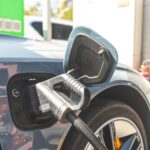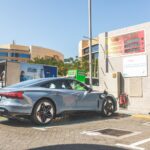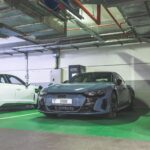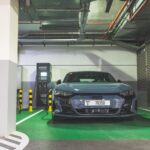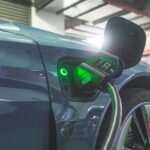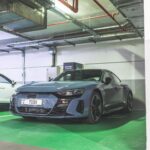Is an oil producing country ready for electric mobility?
The automotive world is in a transition that commonly is being referred to as one of the biggest impacting changes ever to the world surrounding cars and transportation. The industry has embarked on a change from the production of vehicles with internal combustion engines (ICEs) to the production of electric vehicles (EVs). This immediate alteration of the type of vehicle in which we transport ourselves will lead to the restructuring of the existing automotive industry across the globe. Many words have been spoken about the impact of EV production and the availability of EV vehicles in the market space. However, this next story shares my understanding of where we currently stand in the world of electric mobility. This time we won’t focus on Europe, where countries are making decent process on the transition and its deadline of 2035, but in a country which its economy is heavily reliant on revenues from petroleum and natural gas and which ranks eighth globally in readiness for electric mobility; the United Arab Emirates (UAE), a country which is among the world’s ten largest oil producers.
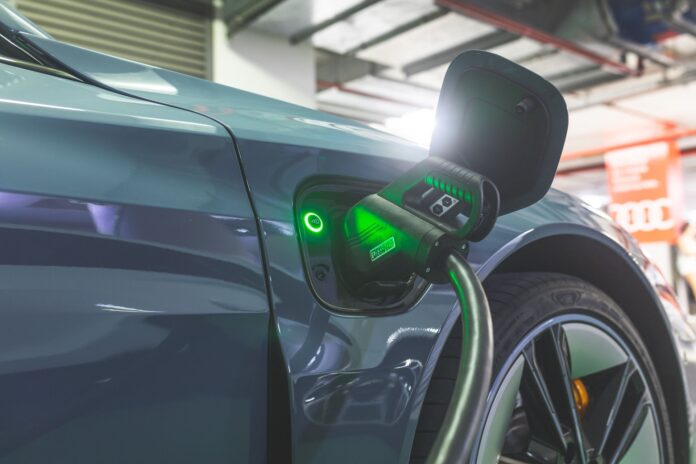
Before touching on the experience itself, it is good to know that the UAE established in 2015 their EV Green Charger Initiative, which is an initiative helping to achieve the Dubai Green Mobility Strategy 2030, promoting green transportation. Additionally under the UAE Vision 2021, the local Arab government plans to install around 175 charging stations to accommodate the rising need for electrification, which is expected to propel the growth of the electric vehicle charging infrastructure market.
More and more market players are investing to find innovative electric vehicle charging solutions across the country, while also upgrading the existing infrastructure to enhance the convenience for drivers. All of this is of course meant to push the growth of the UAE electric vehicle charging infrastructure market forward at an annual rate of 30 per cent between 2022 and 2028, similar to what we read elsewhere across the globe. The aims are therefore similar, the timelines the same. However like many of these stories the reality showcases challenges which seem to be untouched by many and this is where my experience comes in, and it starts even before my trip to the UAE and in particular the emirate of Dubai.
Those familiar with the world of electric vehicles know that it still requires current specific arrangements and in-depth planning. You ask yourself the question where do I charge, what kind of charging speeds are available and do I have the option to charge at home or in my case at my hotel. These are legitimate questions in the current time and age, and also where the challenges start and confusion arose.
The New 2022 Audi RS e-tron GT
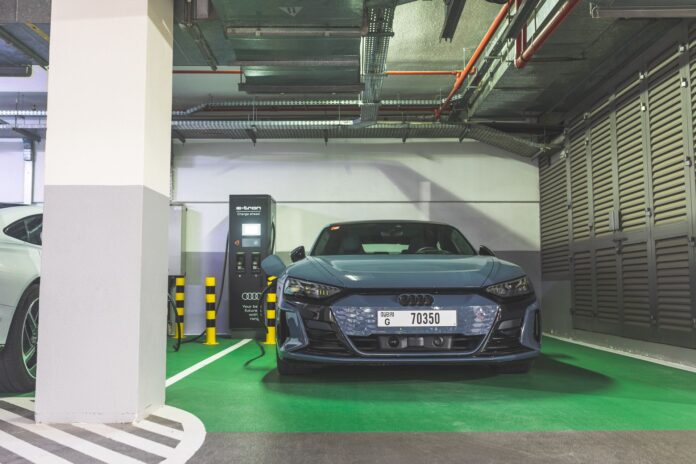
To accommodate my trip to the UAE and support the requirements of being able to move myself around, the team at Audi ME offered me the option to experience the new 2022 RS E-Tron GT. Without starting a long fletch review of the vehicle, I will say that the E-Tron GT is simply fantastic. It is flawed across a number of little aspects, especially noticeable in the UAE market, but pure as a car it might well be one of the best cars on the road today. In Dubai traffic, the vehicle feels like a spaceship ready to take off. At any speed with no time wasted waiting for downshifts, the E-Tron GT catapults you forward with a level of comfort and smoothness not often seen. It is so quick and nippy that any traffic around you feels like it is standing still while you fly past in your silent shuttle.
In the UAE market, Audi fully aims at EV vehicles for the future, especially across its press fleet. The RS E-Tron GT is therefore the car of choice when you want to experience the local electric vehicle infrastructure, which immediately brings me to the first point of note connected directly to the car. The wonderful design of the GT comes with one major downfall which are its front and rear overhangs. Extremely beneficial to its looks and efficient design, the E-tron GT requires you as a driver to raise the car every single time when you park it. This is due to the fact that at the end of almost every single parking space in Dubai you will find a bollard. If you don’t raise the car, you will run into problems completely ripping off the underbody with ease on either side of the GT. Therefore raising it is a must, and valet parking – which seems to be the standard at local hotels and restaurants – is an absolute no-go when you drive the E-Tron GT.
With having the RS GT arranged, let’s step back to the moment of booking the hotel and investigating the local charging infrastructure. I initially asked my legitimate questions in the direction of local contacts, and the answers were almost as expected. “Charging EVs in Dubai is a challenge”, “The infrastructure is not sufficient”, “Hardly any hotels have charging”, “You can only charge in the malls”, “Most chargers don’t even work”. The standard answers which I could have copied from almost every other country across the world right now. Nothing I had not heard before, and the immediate confirmation of what to expect.
Visiting Dubai
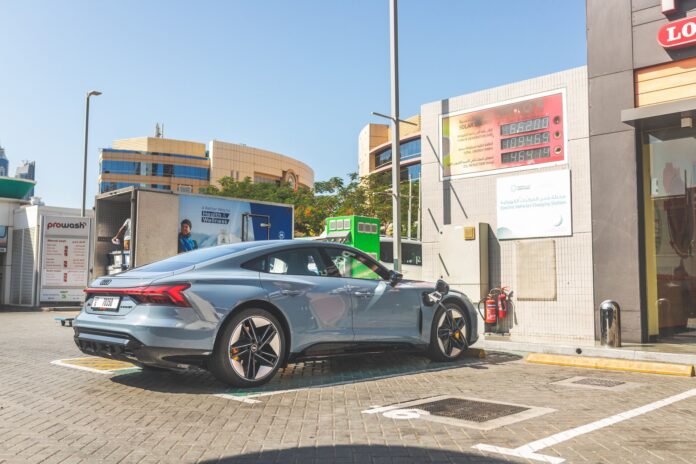
A pleasant surprise came however from the hotel where I stayed in the Dubai Creek Harbour area. Surrounded by numerous commercial developments and a wildlife reserve, the area is the example of a place where you would expect the charging infrastructure to be top notch, since it is so newly build. The booking agent of the hotel confirmed to me that EV charging was on site, he could however not tell me what the charging speed in kW was or how many spaces were available. Also the local mobile apps covering Dubai’s EV infrastructure weren’t able to answer me these questions. Not a huge problem, because as a EV driver you need to be flexible and you are used to crossing your fingers hopping for the best when it comes to filling up your electric car.
With the booking placed, the travel plan set, and a transport arranged, the trip to the UAE could commence allowing for a new experience in a country which runs on oil production. After having arrived on site and with the RS E-Tron GT handed over, the experience started…. in a rather surprising way. First of all, all the hotel employees were completely oblivious when it came to the topic of EV charging. The valets thought they saw water burning when I touched on the topic of charging a car in their parking. Add to this, that hotel’s garage had no lift to bring you up and down, which meant that the valets begged you to have them park your car. But wait a second? If they don’t know what EV charging is and the car needs to be raised every single time you park it, then valet parking isn’t going to be a good idea!

Self-parking became one of thé topics of the total driving experience in the UAE. The sheer amount of times I had to tell valets that they could not park the car became a running gag on its own. In the end, in many instances I required charging (or at least wanted to find out the charging situation in a parking) and since none of them knew what that meant, you as the driver had to park yourself. The hotel garage surprised me however by offering EV charging even though nobody had a fainting clue what this was. The booking agent had been right! Two spots on the 2nd floor were available offering four different charging sockets and three different types of sockets. Luckily the car came with the right plug & cables, and one of the ports was easily occupied. After connecting the car, the shock horror showcased that none of the ports worked because they were heavily vandalized. Back to the hotel’s reception asking for a repair, which was done in record time allowing me to charge the RS E-Tron GT overnight at max 10 kW. Enough to charge the car from 75% to 100% in about 3 hours.
Hotel charging sorted which meant that the problem of range anxiety was solved for this trip. Dubai and the UAE have a relatively small footprint and almost all distances travelled are short, which makes the use of an electric car in this part of the world the obvious choice if a suitable charging infrastructure is available. To answer this thought, a research of the area was needed. In the end, EV charging is still not like filling up a petrol car, so you need to take your time to dive into different mobile apps, check out your area for charging options, make sure you have the correct charging cards on you to allow charging and see if your stops and destinations offer charging accordingly.
Using Mobile Apps for Charging
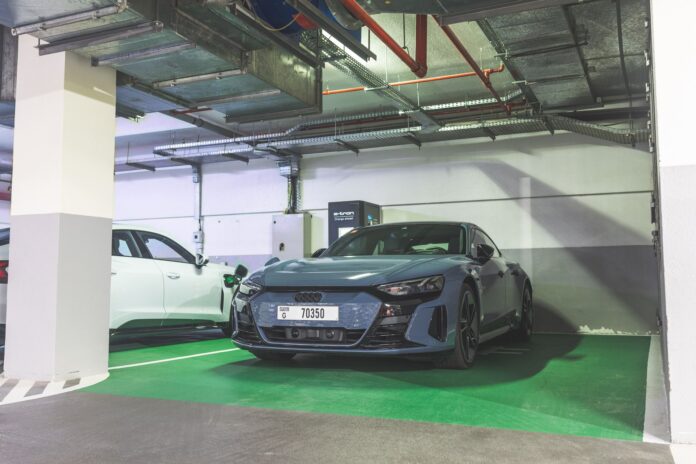
The research brought me initially into the world of two mobile apps. One supplied by the local Dubai Electricity & Water Authority, also known as DEWA, and the second one available called Plugshare, which is a worldwide platform allowing you to find charging options anywhere you go. The combination of both apps offered a great overview of the possibilities on the topic of charging, but immediately showcased the sheer problems we all experience across the globe.
Like anywhere in the world, the UAE’s electric vehicle charging infrastructure market is segmented into vehicle type, type, charging mode, installed location, connector type, type of charging, regional distribution, and competitive landscape. Add to this, the fact that user reports in the app suggested certain chargers offering different charging speeds depending on the day and that chargers were placed at locations which had only daily opening times, and I was in for an even bigger challenge than I thought.
The only option was just to start the drive and experience the different charging options available. Those ranged from Tesla Superchargers and Tesla home chargers in the famous malls of Dubai to high speed chargers positioned at ENOC petrol stations and car dealers, who are trying to sell you their EVs. The first stop was Dubai Mall, only 15 minutes from the hotel, and one of the most famous malls in the world. The location offered a range of chargers, which are immensely hard to find in the maze of parking levels and different garages. Two options were available; the Tesla Supercharger and the 10 kW wall box home chargers which were placed at a number of spots throughout the parking.
The Tesla Supercharger set up in the Dubai Mall is located in the Zabeel part of the Mall, which is not the main parking but part of a newly released expansion. It offers eight Superchargers, is available 24/7, and provides up to 250 kW. The CCS compatibility allowed me to test the E-Tron GT, but with the charging ports on the Tesla’s being at the rear and the cables on the chargers being too short parking alongside a charger became a problem on its own. By claiming three charging spots I was able to connect the charger’s cable to the car to find out that in the UAE non-Tesla’s can’t charge at Tesla Superchargers yet. Bummer…
A second test at the Emirates Dubai mall showed the same problem. However, this location allowed me to have a proper talk with some Tesla drivers waiting for a charge or already charging their vehicles. Their stories revealed that 250 kW was never a thing because the capacity was divided over each of the eight chargers, which meant that when your neighbour left your charging speed would double and your charging time would decrease considerably. Another major issue was the sheer amount of Tesla owners just leaving their cars on charge while going for food or shopping, and many of them being connected and fully charged for hours. This meant that during my visits of these charging locations the waiting line to charge was constantly present. One person even told me he had to wait more than 2 hours before someone came back from his shopping spree in the mall allowing him to charge his Tesla. Not a favourable situation.
By leaving the Superchargers behind, the question came up if the other wall box type chargers located throughout the parking of both malls would work for the RS E-Tron GT. And yes they did and charging was free! Max speed was only 10 kW and also here the capacity was split between different neighbouring chargers, with mostly Tesla’s taking up the charging spots next to normal ICE cars who decided to park on a EV charging spots. Type of behaviour that isn’t uncommon in other parts of the world. Still it was great to see that charging is available in the malls and it is free. However the amount of chargers, the behaviour of car owners and the charging speeds still leave a lot to be desired if we really want to encourage consumers to shift from traditional vehicles.
But my research wasn’t over! There is more to offer on the topic of charging in the UAE. Two common charging locations, which were suggested to me by locals, are the ENOC fuel stations positioned alongside the main highways and car dealers who offer high speed charging to their clients. First up was an ENOC charging station alongside the main corridor of the city, Sheikh Zayed Road and near Dubai Internet City. In the back of the parking lot alongside some of the shops I came across a highspeed DEWA charger which according to the Plugshare mobile app hadn’t functioned for the last 6 months! Luckily you will be able to find other chargers in the immediate area, just no publicly available high speed charging stations. The standard seems to be 22 kW which is then co-shared with your neighbour charging his or her car.
This left me with the final charging option on my list and this was the Audi dealer, Al Nabooda Automobiles located in the Al Quoz area. The local dealer offers charging at its showroom and service centre and I visited the showroom. With the hope of finally having some decent high speed charging ahead of me, I arrived at the dealer with not a single charger insight. After entering the building and asking where the charger was, the valet guided me past two gates and down a ramp into the lowest level of the showroom’s parking. Here I came across a high speed charger capable of achieving 180 kW per bay! After having moved the RS E-Tron GT, the charger showed what it was capable off until the moment I noticed a giant white box standing alongside the charger and which was being aimed at the charger. I immediately noticed that the closet sized box was nothing other than an electrically-powered high-performance air-conditioning unit meant to cool down the charger and the car while charging. The total mindscrew of seeing this left me speechless and it immediately made me understand why the highspeed charger at the petrol station was so long out of service. The hot summer period could definitely have played a role here.
With charging having finished, the valet had to let me out and open the gate so that I could continue my journey. In the end, I charged at the highest speed possible near my location in the UAE, but the charger was only available for Audi E-Tron drivers and only open during commercial working hours, which makes the charger almost completely obsolete to use in normal daily life. Of course, it is great to experience such a sheer charging speed, but with summer temperatures being usually scorchingly hot and hitting up to 50 degrees you tend to wonder if charging with high speed chargers is the best possible solution in these kind of climates.
Still A Long Way To Go For Full Electrification Plans
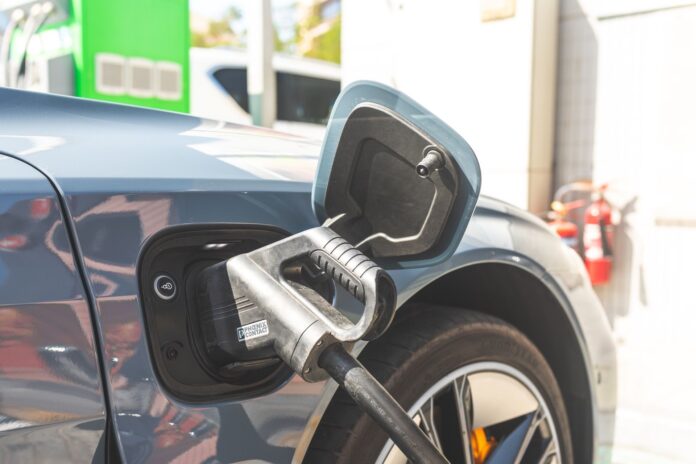
After a week’s worth of EV driving in the UAE, I can say one thing clearly; we have a long way to go before our society is able to embrace EV driving. The UAE is in no way different from countries in central, southern and eastern Europe. The transition has started, and the initial steps have been made, but to create the necessary acceptance around electric vehicles and make it wide spread available we need more than what is currently being done. Next to this, we are forgetting two key ingredients which will impact the direction we have taken heading up to 2030 and beyond.
Ever since the start in 2015 a country like the UAE has made huge progress. The DEWA reported that they provided over 8,800 megawatt hours (MWh) of electricity to charge EVs between 2015 and April 2022. This equates to approximately 58 million kilometres driven. Since the launch of the EV Green Charger initiative, Dubai has seen a good increase in EV adoption, with the number of registered EVs in Dubai increasing from 71 vehicles at the end of 2015 to 7,331 EVs as of May 31, 2022. This upward trend is expected to continue. In 2015, only a handful of EV models were available in Dubai, compared with approximately 25 models in 2022, and more models expected to enter the market over the next few years.
However, this is not where we need to look to make this all work. It is not all about delivering more EV vehicles to the market nor supplying more chargers to the public so that more electric kilometres can be driven. On the contrary, to really make a difference in the direction of adopting EVs we need to take note of the human aspect in all of this, which is the most important aspect within the future success of an EV. As an example look at the available connector types, the market is divided into type 1, type 2, UK 3-Pin, CHAdeMO, CCS, and others. Based on type of charging, the market is divided into slow, fast and ultrafast publicly and home charging which can either be slow or fast. There are too many variables for the public to understand and accept EV charging, let along the valets at hotels, who will need to start learning which charging cables and sockets are available when they are asked to charge a client’s vehicle.
Across the globe, we are forgetting the sheer impact of the human aspect when it comes to adopting new developments. We are aiming at expanding charger networks and increasing EV car fleets, but we forget that the human is the one taking control and without a proper level of standardization, improvements on ease of use and more important adaptability to daily requirements we won’t have EVs become the standard, nor a (full) replacement of the ICE. The predictability and dependability is absent and that is exactly what humanity needs to accept the concept of an EV.
Add to this, the absence of decent grid infrastructures in the world’s cities, rural areas or alongside a simple highway and the ability to charge will continue to be the limiting factor. It will undermine any future plan or green initiative currently in the news and on the tables of the decision makers. With my experiences from Dubai fresh in the back of my mind, I simply can’t understand why the industry and politicians have embarked on a journey, which doesn’t seem to have any point of reflection. Surely there must be a moment they will take off their blinkers allowing them to see where we are really heading, or not?
Don’t get me wrong! The EV has a future, but it isn’t the future when it comes to our immediate transition to a new form of mobility. Of course, cities like Dubai and countries like the UAE will be excellent examples of where the electric car is able to cover the majority of your journeys due to the dense nature of its concrete jungle, but before we are able to achieve this goal we are way beyond the political goals set in 2030 or maybe even 2050. To even get close to these dates, we will have to switch our focus to humanity which is the most vital part in all of this and decide how we will deal with the immediate absence of a sustainable power grid capable of dealing with the expected load. The outcome of this switch will 100% require the internal combination engine to stick around for the time being allowing us to transport ourselves and simply life our lives.
It is inevitable!
[Photos by instagram.com/Nickpcars]

